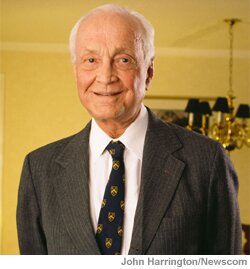Investing At The Point of Maximum Pessimism
John M. Templeton was a wealthy man by the world's standards and his investment strategy in laying up treasure on earth paid off handsomely for him. Unfortunately, it would appear that he was not vested in the Kingdom of God based on this short bio piece. At least we can learn from his wisdom on investment strategy and use it for the good of the Kingdom...
Philanthropist John M. Templeton turned others’ losses into billions of gains
With the country emerging from the Great Depression and war on the horizon, 1939 was probably not a wise time to speculate on Wall Street. But that's what John M. Templeton did, borrowing $10,000 to buy 100 shares of stock in 104 companies that were then trading at $1 a share or less. The rest, as they say, is history. Templeton's innovative investment strategies made him one of the world's richest men, and his riches allowed him to be an equally innovative philanthropist. He died on July 8 at age 95.
Templeton's life, career, and theology defied easy characterization. He was born in 1912 into a poor and poorly educated Presbyterian household in rural Tennessee. He became the first person in his family to graduate from college, supporting himself with odd jobs while studying enough to finish near the top of his class at Yale. From there, he earned a law degree at Oxford on a Rhodes scholarship, and then went straightway to Wall Street, beginning a career there on the eve of World War II. By war's end he was a wealthy man.
His return on the $1-a-share-or-less stocks became part of the Templeton investing mythology, which included the axiom of "buying at the point of maximum pessimism," or buying when everyone else was selling. His student years abroad, World War II's role in globalizing the economy, and a study of where he made money from those original 104 stocks—all these experiences made Templeton an innovator in the burgeoning mutual fund market as well as one of the first major investors in emerging markets such as Japan, Peru, South Korea, and India.
Templeton's theology and philanthropy were likewise idiosyncratic. The main instrument of his philanthropy was his own John Templeton Foundation, best known for its Templeton Prize for "progress in religion." The prize has gone to evangelical leaders such as Bill Bright, Chuck Colson, and Billy Graham, but also to an eclectic assortment of Muslims, Buddhists, and Hindus.
Despite Templeton's association with evangelicals, his own theology was eclectic and by most accounts—including his own and that of the Templeton Foundation—outside the boundaries of traditional Christian orthodoxy.
The foundation's website said that Templeton "took a broad view of spirituality and ethics. He was influenced by the Unity School of Christianity, a movement that espouses a non-literal view of heaven and hell and a shared divinity between God and humanity. As he wrote, 'We realize that our own divinity arises from something more than merely being "God's children" or being "made in his image."' Templeton did not claim to be a theologian, but he was determined to support the work of those who might deepen our 'knowledge and love of God.'"
He wrote at least eight books on spiritual matters, much of it in the same vein: skeptical or opposed to Christian doctrine. He once wrote, for example, that "the heart of true religion is the willingness to see truths in other religions. The Persian scriptures claim, 'Whatever road I take joins the highway that leads to Thee. Broad is the carpet God has spread.'" Yet he remained an elder in the Presbyterian Church (USA) for much of his adult life, and he often hired evangelical Christians to work at his investment firm.
Despite friendship with evangelicals, some of these same evangelical friends—including investor and former Templeton employee Matt MacArthur, who once wrote Templeton an impassioned letter begging him to accept Christ—report that Templeton was never quite able to convert fascination into fealty, interest into admission or conversion.
His most profound fascination remained the creation of wealth, and he gave away hundreds of millions of dollars, most of it to his own foundation or to charities he created. He kept just under $1 billion for himself—enough to land him on The Times of London "Rich List" this year.
But Templeton had his heartaches: His first wife Judith, with whom he had three children, died in 1951. Templeton also outlived his second wife Irene, a daughter, and a stepson.
Far from practicing pessimism, Templeton remained an incurable optimist, using "point of maximum pessimism" to mean the outlook of others.
By: Warren Cole Smith
Source: World Magazine
- July 28, 2008
- Investing
Please login to post a comment.
Member Log In
Register Now
Register now to gain access to all of the resources available on our site. Basic membership is free!

